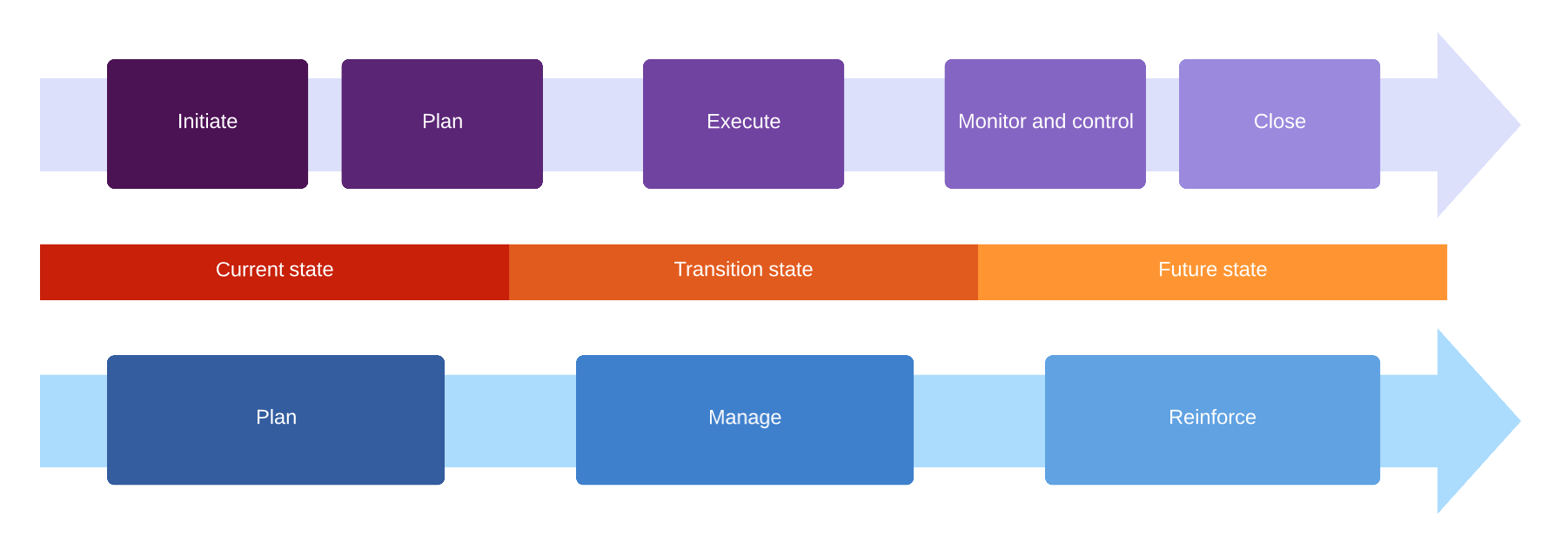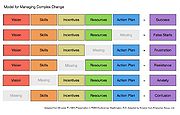Lippitt-Knoster Complex Change Management
(→Big idea) |
(→Big idea) |
||
| Line 25: | Line 25: | ||
- Working with project management, the project manager must be aware of the people included and influenced by the project. | - Working with project management, the project manager must be aware of the people included and influenced by the project. | ||
| − | [[File:PM CM. | + | [[File:PM CM.png]] |
|thumb|Correlation between Project Management and Change Management. Adapted by LucidChart (2023) | |thumb|Correlation between Project Management and Change Management. Adapted by LucidChart (2023) | ||
Revision as of 14:07, 5 May 2023
Contents |
Abstract
The purpose of this wiki article is to give an overview of the Lippitt-Knoster tool for complex change management, and how this relates to project management. When considering project management, one must also consider that projects are led by people, and that most projects are influenced or effected by some sort of change, whether it being a change in deadline, budget, resources, etc. Thus when working with project management, the project manager must consider the effect of changes and thereby change management. In short, when project management and change management are integrated there is a larger change of success [1].
This paper will include a walk-through of the Lippitt-Knoster model and the different aspects included and considered in the model. The paper will consider the usability of the model and how the model can be used in practice, both prior, during and after a project has been completed. Thus, considering if the model can be used to improve further change initiatives and enhance governance in future projects.
Lastly the article will also include aspects of limitations, in regard to the conflict areas, when looking at the model from a theoretical perspective vs. a practice perspective. As Project management and change management are different management diciplines, what are the challenges with them being integrated. Furthermore, the limitations in regard to organisational setup and industry will also be considered when talking about the model and how project management is included, since these aspects have large influence working with both change management and project management.
Big idea
During a project period, It is common that changes occur. This can be in regard to people, resources, timing, budget, etc. For this reason, it is important to account for the effects the changes have on the project and the project team. Hence why change management is an important factor to consider when performing projects and in project management in generel.
A change manager uses strategies that focus on individual achievement and change adaptation. A project manager uses processes that focus on meeting benchmarks and achieving clearly defined objectives. REF
Change management vs. project management [2]. - how and why are they intertwined - When and what makes a project fail? - Resistance and uncertainty arises within both areas of academia and practice
Management of people - Working with project management, the project manager must be aware of the people included and influenced by the project.
|thumb|Correlation between Project Management and Change Management. Adapted by LucidChart (2023) The nature of project management and change management: [3].. - CM: Lewin: unfreeze, move, refreeze - PM: Systems engineering: current situation, xx, Target situation
=> how does these two correlate?
The Model
The Lippitt-Knoster model, as can be seen in the visual to the right, consist of five different aspects to consider, when working with and planning for change. The areas are Vision, Skills, Incentives, Resources and Action Plan, and they are outlining the required elements for successful change, and the possible conflict outcomes, if they are not considered [4]..
Vision
Initially, a Vision for the change must be considered, thus answering the questions 'Why is the change needed?'. Hence, the 'why' is an immensely important aspect, as the people working with the change will experience confusion, if they cannot relate or understand the reason for change and if they ask themself questions such as 'Why should I do this?'.
Skills
Considering the skills needed for change is also important, since the lack of skills among the people working with change will feel anxious about the forth coming change. Here the model seeks to map what skills are needed and if the people working with change have the necessary expertise or training.
Incentives
Another important aspect is the incentive for change. All people working with the change must be able to see the value in the change, or else possible resistance can occur. Here both tangible and intangible incentives should be considered; is the incentive monetary or does it drive personal achievements?
Resources
Resources are also important to consider, and whether the project team has the resources it requires to bring forth the change. If there are not enough resources, it will bring frustration to the people working with the change. Here it would be relevant to consider both internal and/or external resources, and how the dynamics are also influences by the combination of these.
Action Plan
Lastly, it is important to consider the fact that the change should entail an action plan, which should be clear and developed in collaboration with all stakeholders. Without an action plan, the people working with the change could start to feel they are going in no direction and it creates a false start for the project team.
Application
By integrating change management into project management, it can increase the support for the project and reduce resistance, as it combines the people aspects and the projects aspects, thus contributing to achieving the project objectives and realising organisational benefits [5].
- How can the model be used? There are multiple areas, wherein the model can be utilised. Thus, it can both be in the pre project or pre change period, where the model serves as a support tool for mapping areas to focus on and/or areas to assess further before the commencement of the project and/or change [6]. The model can also be used through a change process or project, to identify areas and/or process which are not working as intended within the project og process. Lastly, the model can also be used as a post-project or post-process review framework, to further understand what elements that succeeded and those that did not, and thus why.
Pre-project
As framework for planning change and projects
The Lippitt-Knoster model can be utilised as a pre-project framework work for handling complexity in both project and change management. why is complexity important to consider? [7].
During project
-If and when problems/delays/issues occur - how can the model be utilised for identification?
Post-project review
- How did the project end? - Why / why not was it a succes? - single vs. double loop learning? [3].
Limitation
As change mangement and project management is different diciplines in theory, one does not function in practice without the other.
- performing the analysis is time consuming, and requires a lot of input. This input also needs to be given from all aspects of a project, thus requiring a lot of resources. - you have to account for interdependencies between these areas, as they might not be easily divided in practice. - it does not provide a how to, but just, what is wrong - as manager, you need to either know how to move forward with the results, or be prepared to put in the work and/or plan for this in upcoming projects. -
References
Many of the following references are online articles and conference papers, as the Lippitt-Knoster model was birthed at the XX conference in xxxx, by xx Knoster, when he used the original model by xx Lippitt as sources.
- ↑ Prosci, 2012/2020, https://www.prosci.com/resources/articles/change-management-best-practices. Best Practices In Change Management
- ↑ Hughes, Dwivedi, Simintiras and Rana, 2016. Success and Failure of IS/IT Projects. A State of the Art Analysis and Future Directions
- ↑ 3.0 3.1 John Hayes, 2002/2006/2010/2014, fourth edition, Palgrave Macmillan. The Theory and practice of change management
- ↑ Sergio Caredda, 2020, https://sergiocaredda.eu/organisation/tools/models-the-lippitt-knoster-model-for-managing-complex-change/. Models: The Lippitt-Knoster Model for Managing Complex Change
- ↑ Prosci, https://www.prosci.com/resources/articles/integrating-change-management-and-project-management. Integrating Change Management and Project Management
- ↑ Michael Nanfito, 2015, https://www.linkedin.com/pulse/get-grip-managing-change-deploying-knoster-model-michael-nanfito/. Get a Grip on Managing Change: Deploying the Knoster Model for Successful Implementation
- ↑ Edoardo Favari, 2023, Springer. Project Management: Leading Change in the Age of Complexity

